We’ve all read about it: after decades of construction, a shiny new generation ship is loaded with a crew of bright-eyed optimists. Once the sun is just another bright star in the sky, mutiny and civil war reduce the crew to ignorant peasants…unless something worse happens. This is a narrative pattern set as early as Murray Leinster’s 1935 “Proxima Centauri,” solidified by Heinlein’s 1941 “Universe,” and embraced by authors ever since: human foibles in the confined space of a generation ship ensure calamity. Ideally not of the sort that leave everyone too dead to be interesting.1
But it does not have to go that way! Here are five examples of generation ships that managed to avoid mutiny, civil war, barbarism, and mass cannibalism.
Rite of Passage (1968) by Alexei Panshin

The Ships in Rite are a curious kind of generation ship. They weren’t built; they were excavated. They are vast converted asteroids equipped with faster-than-light drives, designed to transport Earth’s desperate billions to the stars. The original plan seems to have been that once the journey ended, everyone would disembark and the Ships would have been used to establish an industrial base.
The crew of the Ships had what they thought was a better idea: hoard human knowledge for their own and remain in space. The defacto rulers of humanity travel from world to world trading small amounts of the technology they monopolize in exchange for the raw materials they need. It’s not a pleasant system (for the colonies), but it is stable.
Young idealist Mia Havero must first survive her test of adulthood (the rite that gives the book its title) before she can even think of reforming the system into which she was born.
***
Riding the Torch (1974) by Norman Spinrad
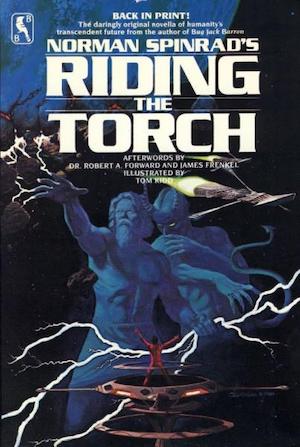
Like the ships in Rite, the mighty Bussard ramjets at the heart of this story were intended as temporary lifeboats to convey the last humans from ruined Earth to new homes. Asyouknowbob, Bussard Ramjets can travel from star to star in just a few years. Unfortunately for humanity as a whole and for artist Jofe D’mahl specifically, despite lifetimes spent looking, none of the stellar systems explored thus far have had habitable worlds.
Instead, humans have been forced to develop increasingly sophisticated technology, therewith to eke out increasing luxurious lives as they travel from system to system. The fleet’s scouts know the truth: habitable worlds are vanishingly rare. Dead Earth might have been the only one. Someone will have to break the news to humanity that the fleet is their permanent home. That someone is Jofe.
***
The Dazzle of Day (1998) by Molly Gloss
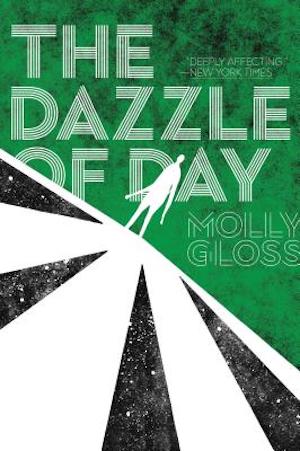
A former space station equipped with vast solar sails, the Dusty Miller takes almost two centuries to reach its extrasolar destination—long enough for any number of horrific social or physical setbacks! Alas, the Dusty Miller’s long voyage was orchestrated by Quakers. The Quakers have been frustrated by an Earth society that resists reform and set out on a journey that will take lifetimes.
Everything keeps working. Not only are the Quakers relentlessly reasonable people, their customs allow them to face disagreements directly and resolve them peaceably. These peculiar arrangements suffice to get the ship across the light years and ensure that their response to the forbidding exoplanet that awaits them is a constructive one.
***
An Unkindness of Ghosts (2017) by Rivers Solomon
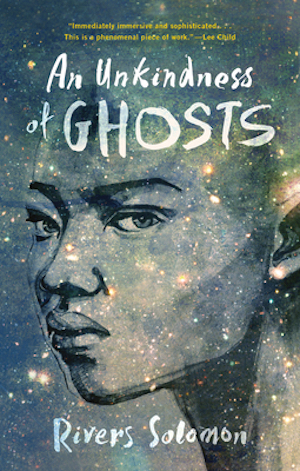
Like Dusty Miller’s creators, the founders who set Matilda on its way had clearly defined mechanisms by which they hoped to ensure their culture’s survival. Unfortunately for protagonist Aster, Matilda’s rulers are patriarchal racists whose purpose is keep their collective boot firmly on the throats of anyone who isn’t white and unambiguously male. They’ve brought a captive population, so that they have someone to dominate.
Aster is brilliant but, since she’s not male and not white, her intelligence only permits her to understand the cage into which she was born. There is no prison so inescapable as a starship in the gulfs of space. Nothing for it but to use her profound intelligence to help her fellow slaves. Or so it seems…
In fact, there’s a mystery on starship Matilda, one that its rulers will never solve but that Aster might.
***
Escaping Exodus (2019) by Nicky Drayden
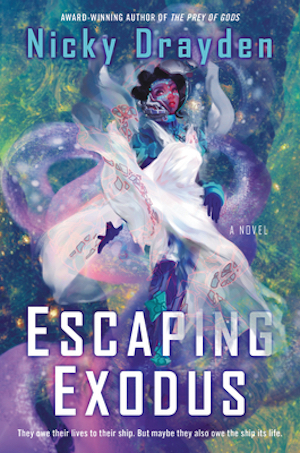
Seske’s ancestors set out across interstellar gulfs to find a new home far from the Solar System. Alas, no New Earth awaited at their destination. Unable to disembark from their aging ships, the colonists settled for exploiting the resource their new home did have: vast space-dwelling beings. This arrangement is slowly fatal to the beasts and offers only a narrow margin of survival for the humans. Nor is it clear that the rigidly hierarchal society Seske will someday lead has done better than to trade immediate death for a lingering one. The lifespan of the beasts her ship infests drops with each beast; the humans may be trapped in a cycle of diminishing returns. Impending extinction is a complete buzzkill for Seske’s already troubled romance with the socially inappropriate Adalla.
Granted, this isn’t a happy ending to the voyage, but at least the humans haven’t reverted to barbarism, as one might have expected…
***
If experience teaches me anything, it’s that for every example I can think of, you folks can think of twenty. Have at it in the comments below.
In the words of Wikipedia editor TexasAndroid, prolific book reviewer and perennial Darwin Award nominee James Davis Nicoll is of “questionable notability.” His work has appeared in Publishers Weekly and Romantic Times as well as on his own websites, James Nicoll Reviews and Young People Read Old SFF (where he is assisted by editor Karen Lofstrom and web person Adrienne L. Travis). He is a four-time finalist for the Best Fan Writer Hugo Award and is surprisingly flammable.
[1]Not that dead people can’t be interesting. Coming soon: five cool corpses!










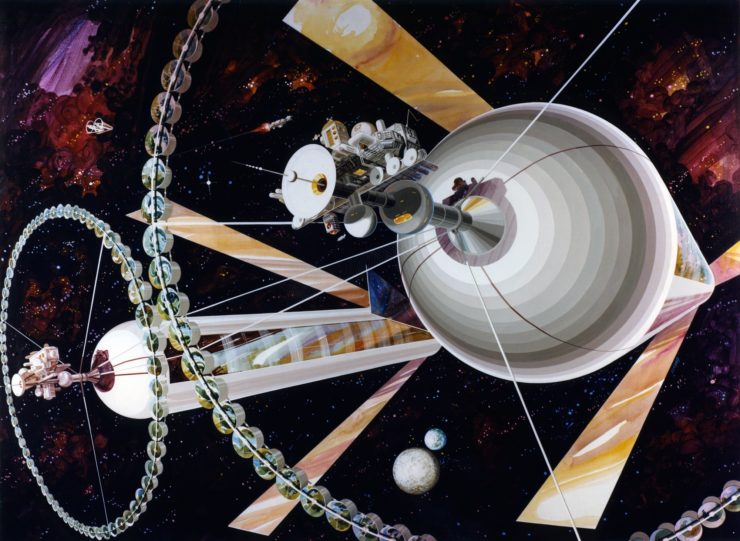
Le Guin’s “Paradises Lost” in her collection The Birthday of the World, is a great example.
Record of a Spaceborn Few by Becky Chambers has a generation ship that doesn’t fail.
I am saving the Chambers for “popular sf novels whose physics make me cry”, along with that Neil Asher where it’s possible to heat objects to fusion heat with reflected solar light.
The Exiles Trilogy by Ben Bova.
I must say that these are examples of generation ship plans that did not end in disaster only if you employ a very specific and narrow definition of “disaster” (or perhaps a very specific definition of “end.”) I’d say four of the five are basically dystopias, which seems like a good definition of “resulting in disaster” to me.
I’d like to mention “Learning the World” by Ken Macleod here: generation ship from utopian post-scarcity human civilization arrives at destination only to discover that the world is inconveniently occupied by the first non-human sentients anyone has encountered—also, they’re a technological civilization (albeit backwards by generation-ship-building standards).
As it happens there is strife over what to do—but it’s generational, among the humans, nobody is advocating genocide or conquest of the locals, and it’s resolved fairly amicably.
By the third Exiles book, the crew is down to 56 ignorant young adults and their less than stellar mentor, who hasn’t checked in on his charges in person for years.
@5 Since they were intentional dystopias, they started as disasters rather than resulting in them. Though it’s common for generation ships to start with Earth-wide disasters. Though only two of the five here explicitly say Earth is ruined or dead.
I don’t suppose that stealing a Mormon generation ship in order to crash it into an asteroid counts…
Loved the Molly Gloss. Teaches the difficulty of change.
IIRC, most of the generation ships in Delany’s “The Ballad of Beta-2” make it to their destination reasonably intact (though the story deals with the ones that didn’t.)
The starship in Brian Stableford’s “Dark Ararat” has some factional infighting by the time it reaches its target, but it’s reasonably polite and low-level stuff – society hasn’t broken down or anything like that.
Does the Whorl in Gene Wolfe’s “Book of the Long Sun” count? It’s only when it arrives at the Blue-Green system that things start going peculiar….
IMO, Rite of Passage is a cheat on your title; generation ships stagnate because they have no outside contact due to spending decades or centuries in interstellar space, where Panshin’s FTL asteroids visit another colony planet at least every 3 months (because that’s when another Rite class is due for their solos); the fact that they dropped most of their passengers also gives them room for soccer games and a breeding population of tigers, so they aren’t living in each others’ faces. It’s also not clear to me that the plan changed; I’ve just reskimmed the first few chapters and they read as if the plan was always to dump peasants on a lot of planets and feed them tech like a giant bookmobile. (With 8 ships and (originally) 112 planets, keeping the tech concentrated might have seemed like a good idea to people who weren’t thinking that peasants can also learn tech and advance themselves.) Can you point to a passage that shows the original plan as gentler?
re Gloss: I wonder whether Quaker methods in isolation really would produce zero children who couldn’t be persuaded to conform to reason, and how resilient the system would be in the face of any such. Russell’s “And Then There Were None…” proposed refusing support to “scratchers” — but that’s a lot harder in a closed ship than on a planet.
@6: I thought of “Learning the World” too – but it’s not quite a generation ship as usually understood. The generation that started off on the trip are still alive when the ship arrives at its destination (long lives), and the new generation is only born when the ship is close enough to the target that the new ones will be young adults at arrival.
Jo Walton’s short story Turnover is about a generation ship population who begins to realize the advantages of ship-based life. https://www.lightspeedmagazine.com/fiction/turnover/
@3: Understood. Chambers has bizarre stuff like generating power by water flow on a ship where the power required to move the water uphill in the first place is apparently free (and power generated by walking – without mentioning the power required to grow the food that allows the walking to happen) talked about on the same page as solid physics like antigravity generators and ansibles…
Gene Wolfe’s Book of the Long Sun comes to mind… Published by Tor.
How about The Dark Beyond the Stars by Frank Michael Robinson?
I’m happy for “An Unkindness of Ghosts” to get a bit of hype, I thought it was fantastic. But I’d argue that’s a DOUBLE diasaster, with both societal and technological breakdown.
Not so much weird physics as weird biology- Janet Kagan’s Mirabile had generation ships that made it safely to the new planet, with only a pandemic or two and a computer crash along the way. (said disasters were able to set up the plot)
Never mind – I inadvertently duplicated a post.
I’d say most of the planets in Weber’s Honor Harrington-verse were settled by generation ships.
@21: Manticore and Grayson were settled with hibernation ships – but some of the earliest colonies must have been generation ships.
In Edmund Cooper’s Seed of Light (1960). the very small crew (about 10 people I think?) never gets any larger because of available space. Eventually they do degenerate, but the ship still somehow keeps going, and a later generation recovers the knowledge. (rot13 spoiler) Gurl arire svaq n unovgnoyr cynarg naq riraghnyyl gurl gnxr na SGY whzc gung gheaf bhg gb or n gvzr-geniry whzc onpx gb ceruvfgbevp Rnegu.
@22 – thanks for the clarification.
Two of David Weber’s Honorverse books talks about Generation ships that made it to their target safely. But both of them turned out to be long term disasters as the first planet was contaminated by heavy metals that altered the human genome from 50/50 male/female to 10/90 male/female. The second ship’s destination planet was beautiful on paper but had an 18 ??? month vicious winter cycle in which the colonists starved. In both cases the people barely survived but took hundreds of years to thrive.
Kim Stanley Robinson’s Aurora is a careful look at generation ship design and operation. It reaches its goal with its crew still civilized, but they find that the target world isn’t inhabitable, so they have to come back to Earth. Not the happiest of endings, but most of the crew do make it back.
New York New York of james Blish’s flying cities series?
and more recently, jane Emerson city of diamonds.
Both have quirks but are cities/ships that travel for generations.
Oh! I had forgotten all about Rite of Passage. I read back in 1973, maybe? Will have to read it again
Colony Fleet, by Susan R Matthews.
I always liked Kevin O’Donnell’s Mayflies. Bussard ship becomes generation ship because the Central Computer’s remnant human personality shuts off the ram scoop. Generations of stress and complications ensue, but a there’s a surprisingly hopeful conclusion.
Rite of Passage ended in disaster for the colony that hosted the most recent right of passage.
It doesn’t speak well of the health of the ship, either. The citizens vote to commit planetary genocide. And think themselves justified. That is a disaster of a different kind for the ship.
The citizens of this and/or other ships have done this before and ~survived; early, unwoke-Mia casually mentions that the 112 original colonies are now down to 90, as some failed and some “had to be disciplined”. But woke-Mia (“There’s not a single solitary spear-carrier among them.”), and Jimmy, and probably others of their generation, and ~40% of the ship’s population oppose this move — and the author lets us hope that at some point they’ll outnumber the ones who support it. It’s possible Panshin intended an analogy to the US’s blatant attack on the Philippines (7 decades before), or the more-subtle mischief that continued in Latin America, or maybe even Vietnam (around its peak when the book came out), and hoped for better, as suggested by “How Can We Sink When We Can Fly?”
Another suggestion, given that the columnist allows FTL frequent-contact ships as well as slow isolated ones: Sisu, in Heinlein’s Citizen of the Galaxy. (We know there are many other similar ships; I think we’re given at least one name but I’m blanking on it.) Some young women move once from one ship to another, but it reads as if many of them and all of the males are born and die on the same ship. This is a limited society in some ways, but it seems to have lasted for generations and to be stable into the future — for 1950’s versions of stability. (Today some of the discussions of women on the merchant ships are gag-worthy.)
Strongly disagree w/ Unkindness of Ghosts. It’s a great book, but devastatingly sad and I think slavery and racist violence qualify as disaster just as much (maybe more than) civil war and mutiny.
@24: No problem (and sorry for being a nitpicker).
I could easily add 2 great books to this list. The Dark Beyond the Stars by Frank Michael Robinson (it does involve mutiny but it’s a really good generation ship story) and Ship of Fools by Richard Paul Russo
A Culture GSV?
There is a story that links Rite of Passage to the Anthony Villiers books, so eventually the age of the Ships will end, to be replaced by a much larger empire I am sure all the humans think it peachy. The Trogs may have a different view.
Noumon by Marina j. Lostetter has a generation fleet that works, though with some crew created hiccups on the way.
What about James Blish’s Cities in Flight tetralogy?
@38,
There is?
Oh my – if you guys have not read James P. Hogan’s _Voyage From Yesteryear_ run and go find a copy!
Doesnthe trip end successfully? Boy Howdy!
In the Orthogonal series by Greg Egan, the generation ship completes its mission successfully. The mission isn’t to colonize another planet but to take advantage of time dilation to get extra time to invent something to save the home planet
Respect for the master:
What about Heinlein’s Orphans of the Sky!
@44: The article mentions the first half of “Orphans of the Sky” in the first paragraph – Heinlein’s novella “Universe”; a generation ship that has society devolve into a hidebound theocracy that has forgotten where it is, and persecutes a substantial portion of its population would count as a failure by JDN’s lights…
41: I think it’s “Sky Blue” in Farewell to Yesterday’s Tomorrows.
I’m not certain if she says so in Universe, but in Lois McMaster Bujold’s Vorkosigian Saga, a generation ship successfully settled Beta Colony – the leading source of technological innovation – with long lasting effects on its’ society; t.ex. rigorous control of fertility and government enforced personality control i.e. “Therapy” for those who contravene societal rules. Of course, this is background world building, not the novels’ subjects.
The Romulan Way by Diane Duane is a great generation ship story interwoven with a story set in the later resulting culture, and I second Janet Kagan’s Mirabile!
Weren’t most of the worlds in Niven’s Known Space stories colonized by generation ships? They were definitely STL ships.
Aurora by Kim Stanley Robinson is my fave in this genre.
There’s a generation ship in Restaurant at the End of the Universe by Douglas Adams, and it was leaving no dystopic planet, it was just stuffed full of all the extraneous people like hairdressers and life wellness coaches. And it would have arrived fine if any of these people were actually capable of landing a starship….
Also Dragonsdawn by Anne McCaffrey starts on a generational ship, they only encounter problems years after settling on Pern.
I was thinking the same thing about Niven’s series. They were definitely STL ships that founded successful colonies.
Also, in one of James White’s Sector General series (Ambulance Ship, I believe), there is an encounter with a derelict generation ship, but I don’t think it was the only one. I believe there were other, successful ships.
Long, Long Ago, Boy’s Life (which had several SF serials) had a series of stories set on a generation ship that was approaching its destination, and then after they made planetfall. (One of the adolescent protagonists, I remember, was astonished at how tiny things go when they were far away). The ship’s society and command structure were intact and equitable, and they arrived safely and begun the colonization process. The biggest problem I remember were juvenile delinquents among the bored youngest set. No idea who wrote the thing, though now I have to go research it…
@chris 49, @Bob 52
The Known Space STL colony ships were sleeper ships with small crews of awake humans, not traditional generation ships. I can’t remember this many years later whether the crew were awake for the entire journey (and had to reproduce) or if they were on shifts.
I also thought of the New Sun books, and like so much of Wolfe he turns a lot of tropes sideways. It’s pretty clear the passengers never knew they were on a “spaceship”. And the trip goes smoothly, but something (it’s a mystery I won’t spoil) leads to the ships never trying to disembark after arrival at their destination. So the trip was successful on its own terms but then it all went bad.
CHiP @@@@@ 12 On Quaker generation ships and their discontents:
Having been raised by a mother from an old family of Friends (Quakers), and grown up with some loose exposure to Quaker Meetings, I think I can say that the Friends tend towards extremely stubborn on the average and most groups have outliers who are incredibly more stubborn and unreasonable than all the others. (Not surprising really, to find this in a sect that grew out of simply refusing to comply with authority no matter what they were threatened with.)
Meeting seems to manage to deal with them, mostly through even more unreasonable levels of patience and counter-stubbornness, but also through general openness to being convinced of being wrong.* Of course in current society, there’s always the option of those who don’t get along simply leaving, which isn’t available on a spaceship. Nonetheless, I can imagine the Quaker approach might work better than most over generations in space.
As I grow older, I have gradually realized that much of my ancestry on my mother’s side for generations has been somewhere between very eccentric and fairly nuts, and the social institutions that helped them cope with that – and others cope with them – have my respect.
* (I deleted here a long footnote about John Woolman’s approach to convincing Quakers in America to renounce slavery. It’s not directly relevant, but it’s interesting history and worth reading about though, for the curious!)
If you don’t mind a little mutiny where everyone is fine at the end, the The Silent Stars Go By by James White is great. It also throws in some alternate history. It’s a great book. I need to reread it now.
Destiny’s Cradle, by Paul Crawford, is a generation starship novel published in 2019. The starship Destiny is on a thousand-year voyage to colonize a distant planet. However, a series of long forgotten crises has left the crew’s descendants trapped for generations within the starship’s Earth-like biosphere, its exits locked and its walls, shielded by a holographic force field, invisible to everyone inside. The inhabitants have been trapped for so long that they no longer even know they’re on a starship. The biosphere is all the world they know. The sudden appearance of a complete stranger, seemingly out of nowhere, threatens the stability of the starship’s rustic community.
I think Children of Ruin by Adrian Tchaikovsky would be an excellent addition to this list.
@@@@@ 51 The ships in Dragonsdawn were sleeper ships. Crew were on 5 year wake cycles, and everybody else was in cryosleep.
There’s also Pamela Sargent’s Earthseed series..Though it’s got a rocky start, the Ship does leave behind a successful colony,
Could we have another article on five times it did NOT go well? I submit the Flood/Ark duology (with epilogues) by Stephen Baxter. Ugh. Want to get depressed? Read those.
CliftonR @55, you have a way with words!
NOUMENON by Marina J. Lostetter (2017). An Earth expedition composed of a convoy of nine ships, goes on a voyage to confirm the existence of other intelligent life in the universe. The mission will take centuries ship time, with thousands of years passing on Earth. A generational crew of clones is created from individuals selected for their DNA after a meticulous screening of their personal and family backgrounds. The purpose being to insure the health and psychological stability of future generations throughout the outgoing voyage and the eventual return to Earth. While there are some issues over the long period of time (more to do with personality or social conflicts within the changing crew than anything else) the overall mission is non-hostile and non-disastrous. There are two other titles in the series that follow through with the same generational concept: NOUMENON INFINITY (2019) & NOUMENON ULTRA (2020).
Tau Zero from Poul Anderson? Read it many years ago and I think it wasn’t intended to be a generation ship but it ends up as such because of the accidental extreme high speed and consequent difgiculties to stop? Or it it simply the time dilatation effect that is so huge that makes it feel like a generation ship?
One might mention C. J. Cherryh’s tour d’ force Foreigner series, soon up to 21 volumes with no resolution yet in sight. From the Amazon intro:
“The groundbreaking novel that launched Cherryh’s eponymous space opera series of first contact and its consequences…
It had been nearly five centuries since the starship Phoenix, lost in space and desperately searching for the nearest G5 star, had encountered the planet of the atevi.”
After a bloody war of human vs. Atevi, mostly due to the two sides misunderstanding each other, an uneasy truce is obtained and maintained by humans being restricted to a very large island, and trading their technology for needed items from the Atevi, with a single human allowed on the Atevi continent as an ambassador with the difficult job of easing communication between the adversaries. So far war has been avoided for 200 years and 20 volumes, with another book due very soon. Read chronologically, and start with the first. I’m betting you will get sucked in, as Bren Cameron, the current diplomat tries to maintain peace while warding off the occasional expected legal (and sometimes illegal) assassination attempts with the help of his trusted Atevi assassins/bodyguards. As in the past, Cherryh proves a master at depicting alien/human conflicts. The books mostly cover these conflicts and how they are resolved, but her story starts with a desperate generation ship sending some of its passengers down, and what happens on the ship when it shows up again 200 years later.
I think the YA book mentioned by Prof.Liddle-Oldman may be Milton Lesser’s The Star Seekers. One of my favorites as a child.
I’m surprised no one has mentioned Clifford Simak’s “Target Generation.” Despite a continuity scheme as improbable as the one in City of Ember, Simak’s people arrive successfully at their destination — though they have to be forced out of the ship bodily when they get there!
“Slow Train to Arcturus” by Eric Flint and Dave Freer is in the vein of the B Ark from the Hitchhiker’s Guide books. Several groups of people left Earth (perhaps not entirely voluntarily) in a generation ship, each group provided with their own habitat. Supposedly several habitable planets had been identified and the plan was to drop off one habitat at each.
Aliens discover the ship and board it. Unfortunately the habitat they enter first is populated by people who seem to be “extreme preppers”, well armed and over the years grown highly distrustful of one another. Most of the boarding party are killed.
The aliens make their way through other habitats. one clearly based on Communists from North Korea, worshiping “Dear Leader”. Another is inhabited by Amish/Mennonite, and yet another is extreme feminist where women hold absolute rule and men aren’t allowed to wear clothes.
Starburst by Frederick Pohl would fit in this list.
Perry Rhodan had at least one mission successful generation ship in Spaceship of the Ancestors.
Of course there they are sticking the population in stasis tubes when they reach the age of 30 to stock up a population to colonise their destination.
And then an FTL starship drops back into space nearby and an alien teleports on board and overthrows their management AI.
The Eon trilogy by Greg Bear has a colony ship and it’s not all disaster.
Prof.Liddle-Oldman, you’re thinking of Dale Colombo’s stories about the generation starship Magellan. Here’s a link that will get you to online versions:
https://beamjockey.livejournal.com/182596.html